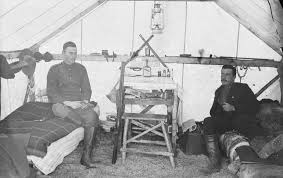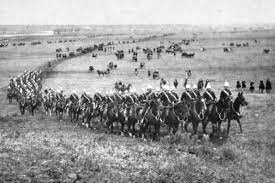From column# 421 The Time Traveller NWMP
A NEW MOUNTAIN RANGE
The Indians stated that the mountains ran “many day’s journey” to the south, and the river which they had found was known as “the river where once lived the strong men who were not afraid of the rapids.”
Mellor and Johnson went only to the edge of the mountains, gathering data sufficient to show that the Caribou Mountains, instead of terminating seventy miles from the Peace River, as shown by the existing maps, extended close up to the southern shore of the Great Slave Lake. Had it not been for an almost accidental foresight on Mellor’s part the two would never have returned from their romantic and perilous journey. In a swift rapid in the heart of the sulphur country, where they were completely hemmed in for hundreds of square miles by small lakes and streams and impenetrable swamps, their canoe was wracked upon a rock and all their supplies lost. By a strange and fortunate chance the explorers had cached a small part of their supplies within ten miles of where this accident occurred. After practically rebuilding their canoe they reached this cache in an exhausted condition and from there resumed their journey through a country barren of food and life down to the Great Slave Lake.
There are many who believe that instead of being nearly extinct, there is a country somewhere in the unknown lands of the north where vast herds of buffalo still roam. Since 1908 half a dozen expeditions have been sent out by the police to search for buffalo. A few years ago it was believed that only a few solitary head existed, but since that many herds have been discovered. In March and April of 1909 a patrol north-west of Smith’s Landing discovered several herds, the largest of which numbered seventy-five head. At the same time a patrol was sent into the country to the south-east and reported two hundred buffalo.
Both expeditions found the whole country through which they passed, and which was heavily covered with timber and bush, literally cut up with buffalo trails and infested by hundreds of wolves. In the autumn of last year a Corporal Bates found two hundred buffalo in one herd, and a hundred in another, near the Caribou Mountains, and came upon other herds numbering from ten to twenty head. All these expeditions have strengthened the conviction that large herds still exist in the unexplored country south of the Great Slave Lake, and also in the vast “plain” country between the Great Slave and the Great Bear Lakes.

TROPICAL LANDS in the ARCTIC REGION
Several times during the past decade the men of this remarkable police force have investigated what are known as “ mastodon finds” in various parts of the Frozen North. The remains of several of these animals have been found in a state of perfect preservation. The flesh had been fresh enough to eat, and in the stomachs of the prehistoric monsters, in at least two instances, there have been found the undigested tropical foods upon which they fed.
Superintendent A.E.Snyder, commanding the Royal Mounted at Whitehorse, Yukon Territory, reported to the Commissioner in 1909 that from north of the Porcupine River there had come repeated rumors of the existence of a wonderful tropical region which was still inhabited by mastodons. “The Indians,” concluded Superintendent Snyder, “report having seen the gigantic tracks of these animals.”
Little attention was paid to these stories, however, until November of 1912 when C.J. McIntyre and two companions made a most amazing discovery north of the Porcupine River. They were travelling by dog-sledge, with the thermometer at forty below zero, when, to their astonishment, the temperature began to rise so rapidly that within a space of two hours they had thrown off their warm garments and the snow was soft underfoot.
TBC
